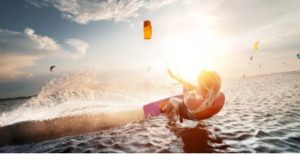Surf foilingis an alternative to surfing, allowing you to ride waves that would normally break away from you. The foil harnesses the energy that is typically lost through contact with the water, so it generates much more speed.
Foiling also allows riders to glide for long rides on small bumps that would otherwise leave them wiped out on the beach. To do this, you need to master the hop/glide and cutback techniques.
Equipment
 The foiling experience is unlike traditional surfing, and mastering the craft requires some special equipment. Foils require a lot of energy to lift the rider and can be dangerous if not handled properly. It also requires a different stance and learning how to balance on the board. Foil surfing is not as easy as riding a wave on a regular surfboard, but it can be just as rewarding and fun.
The foiling experience is unlike traditional surfing, and mastering the craft requires some special equipment. Foils require a lot of energy to lift the rider and can be dangerous if not handled properly. It also requires a different stance and learning how to balance on the board. Foil surfing is not as easy as riding a wave on a regular surfboard, but it can be just as rewarding and fun.
When choosing a surf foil, look for one with a large wingspan to give you good stability and control while surfing. Choose a mast length that suits your height and weight, and don’t forget to add accessories like fins, stabilisers, rack pads, and bags for your equipment. These accessories will make your ride more enjoyable and help you get the most out of your surf foil.
The grip is also important for foiling, and it is recommended that beginners start with a thicker traction pad to help them maintain their balance while riding. The traction pad can be placed on the bottom of the board or top, and it should cover a large area to provide adequate grip.
The sizing of the surf foil is also important, and it is recommended that beginners choose a larger board to begin with. It will help them gain confidence and improve their skills. They can then downgrade to a smaller board as they become more experienced.
Board
Foiling allows surfers to ride waves that would normally be unrideable. It works by using the wings of the foil to lift the board above the surface, reducing friction and creating speed. It is an extremely exhilarating and fun sport, but it also requires a lot of practice to be successful.
Foil
Unlike regular surfboards, foil boards harness and transmit energy from the ocean into the board without losing it through friction on the water’s surface. It means that surf foiling requires a lot of body power to get going. But once you’re up and riding, it feels incredible. It’s a bit like snowboarding in chest-deep powder; only you’re riding a surfboard. The feeling is unbelievable, and it’s something that all surfers should experience at least once.
To begin learning to foil, find some small crumbly waves to practice on. It will help you build up speed and understand how to control the foil with your front foot. You’ll want to stay away from crowded surf locations as it’s important to focus all of your attention on the wing and foil, as well as staying safe.
Sizing
Foiling is a lot easier if you have previous water sports experience. If you have sat on the back of a surfboard, prone or stand-up paddle board, kite surfing, windsurfing, water skiing, or wakeboarding, you have a head start. Having a strong grip on the water is also very important. Foiling requires a very high level of control and balance.
In addition to choosing the right board and foil for surf foiling, you need the right mast length for your ability. For beginners, a 24” – 28” mast will work well. Once you get the hang of the sport, a longer mast will offer more speed and manoeuvrability.
Foiling surfers should stay away from busy breaks, as crowded waters can cause dangerous situations. It is also a good idea for beginners to surf with an experienced surfer. Having someone who can guide you through the basics will make your first rides a breeze. Foiling is a very safe sport, but it can be very challenging. It takes time and practice to master. Once you do, it opens up a whole new world of wave riding, and the possibilities are endless.
